Machine Learning Researcher Resume Examples

Jul 18, 2024
|
12 min read
"Crafting your machine learning researcher resume: highlight your skills and experience to create an algorithm for success in the job market. Make your qualifications stand out and catch the eye of hiring managers using these tips."
Rated by 348 people
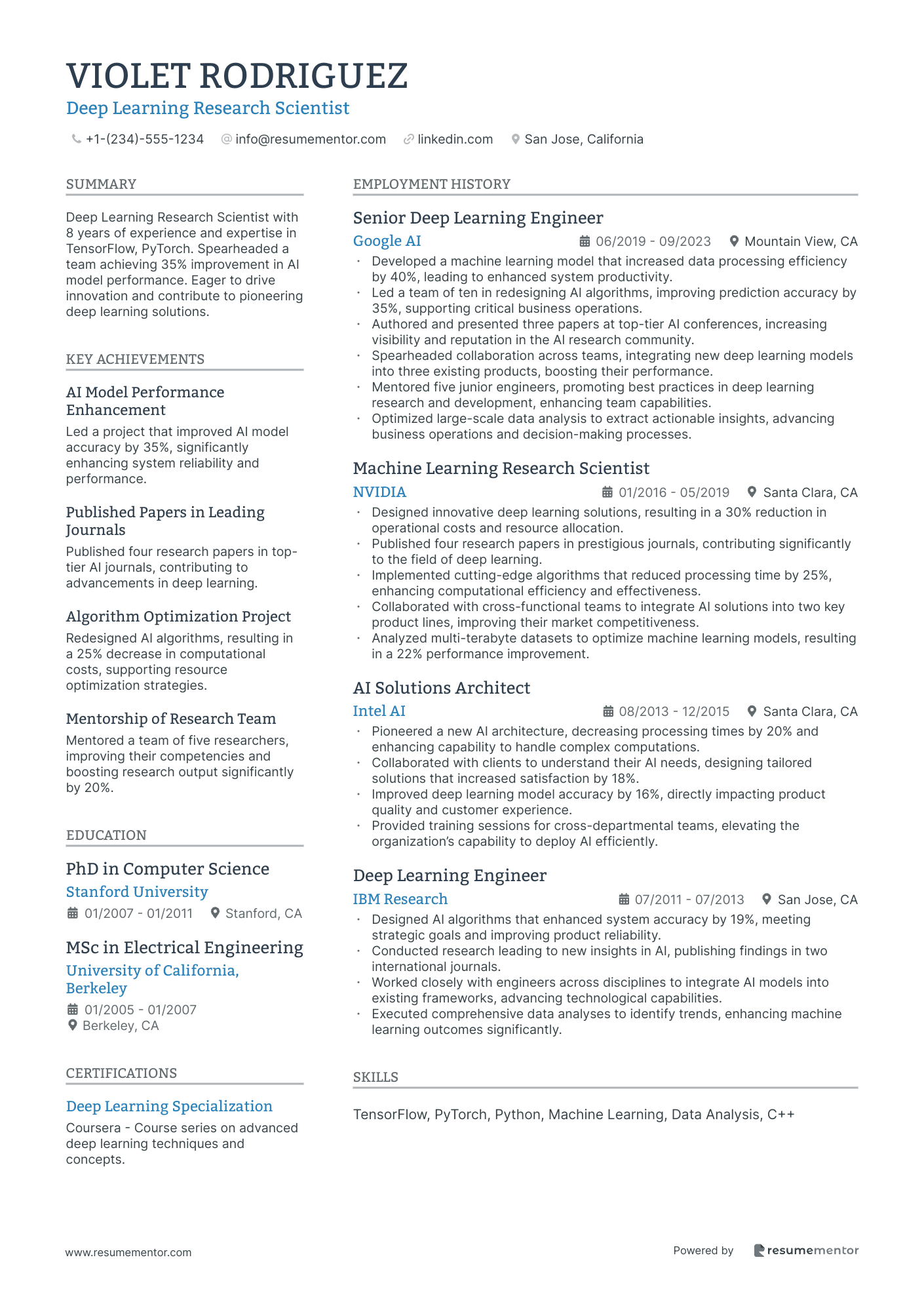
Deep Learning Research Scientist
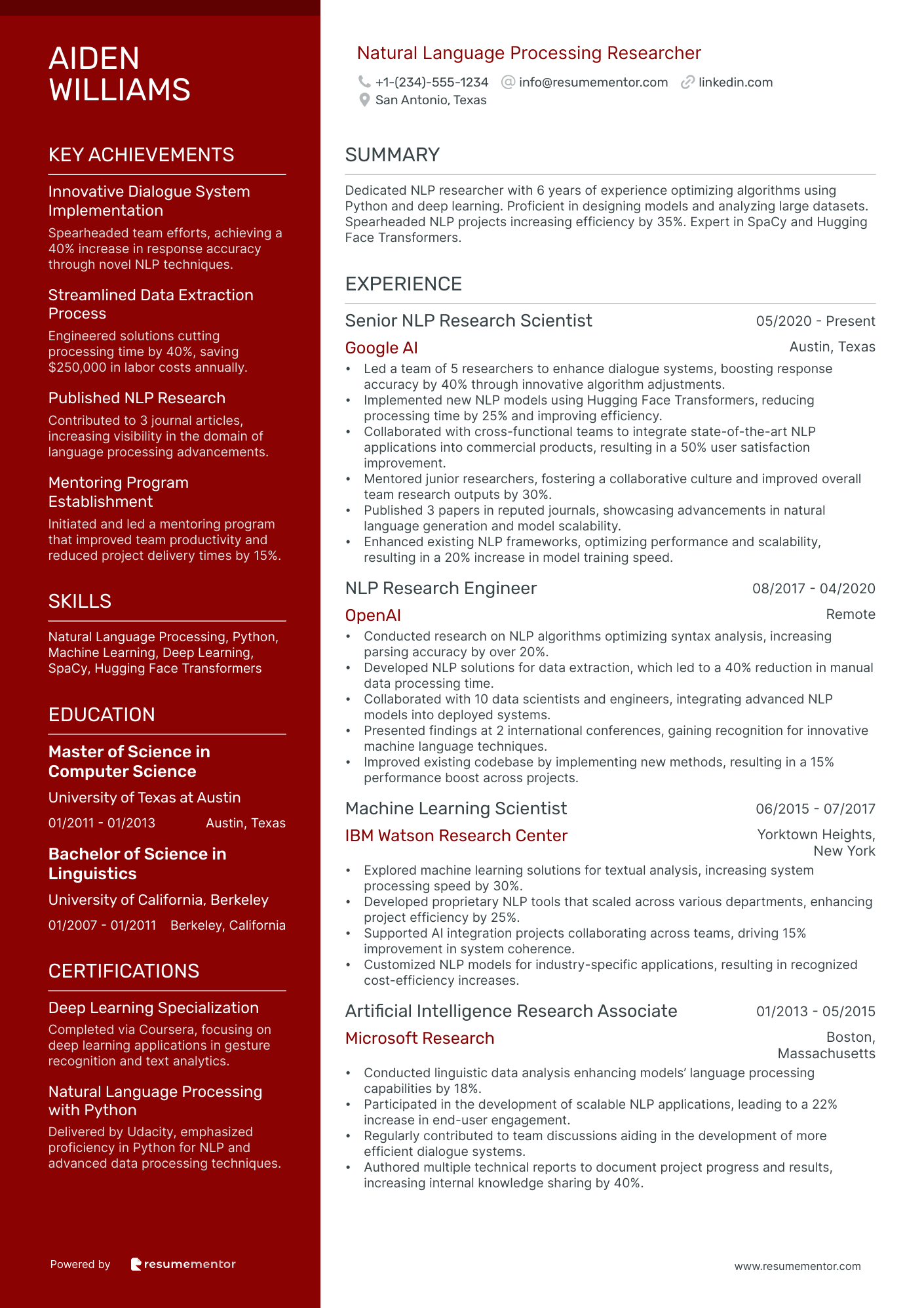
Natural Language Processing Researcher
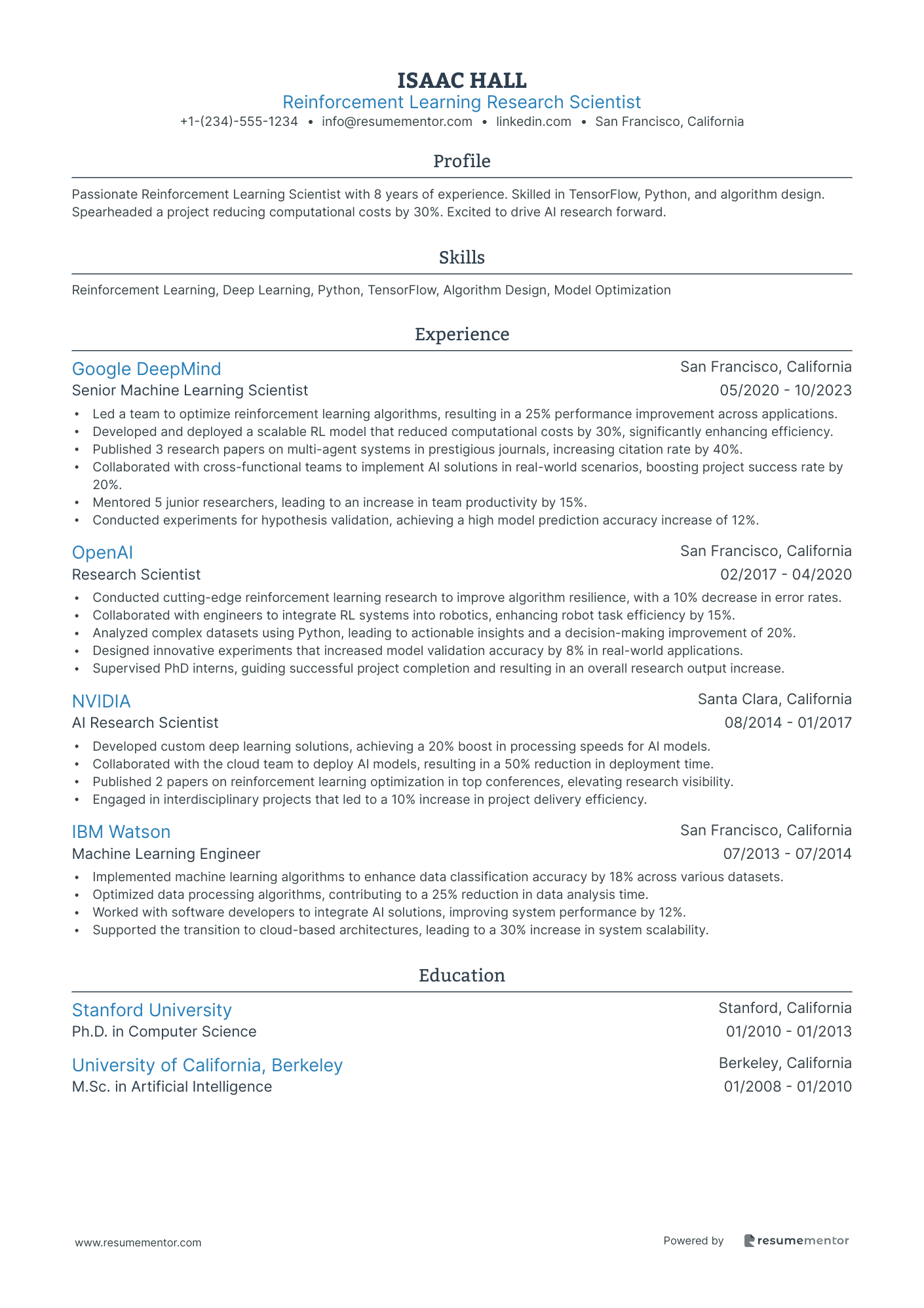
Reinforcement Learning Research Scientist
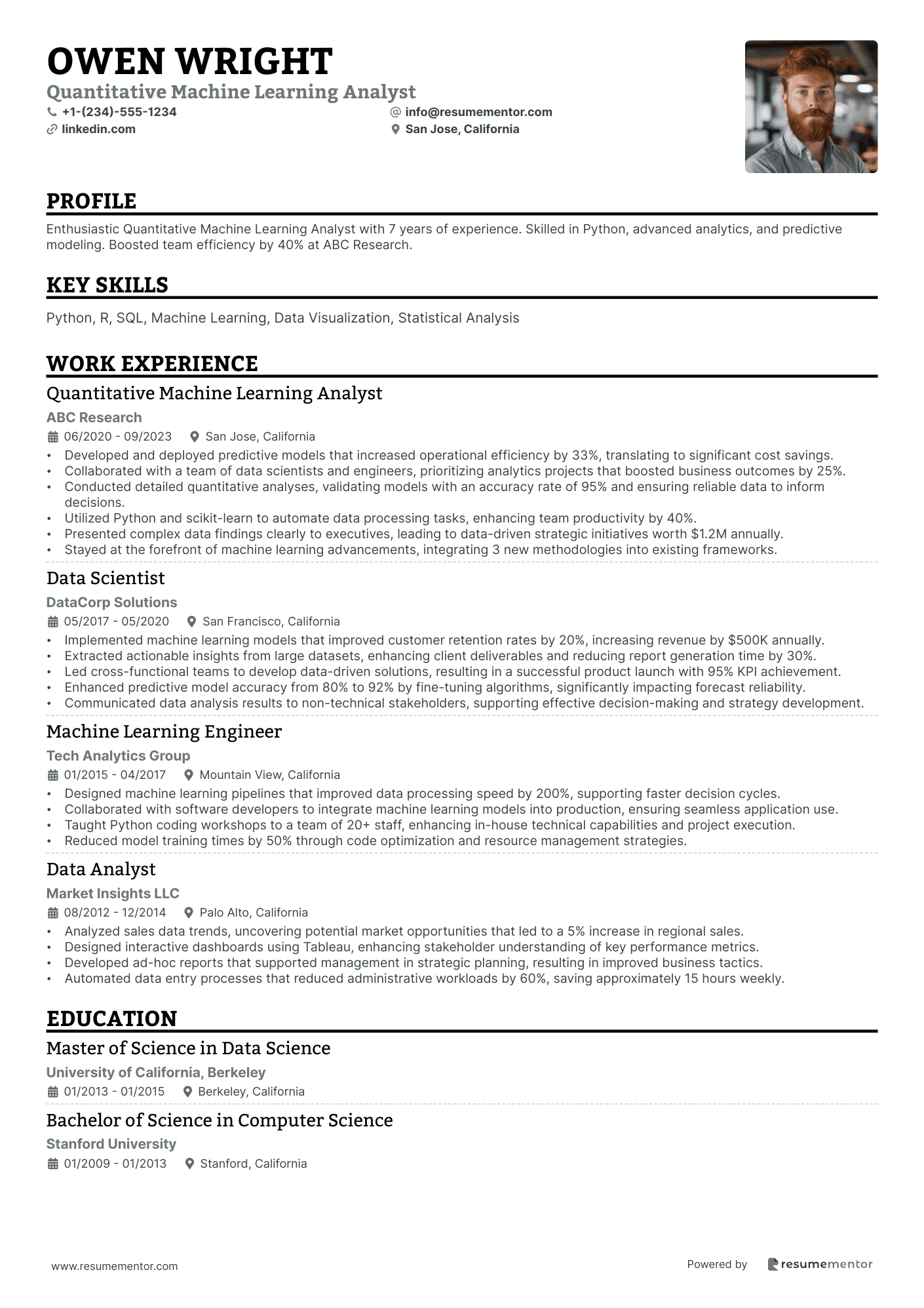
Quantitative Machine Learning Analyst
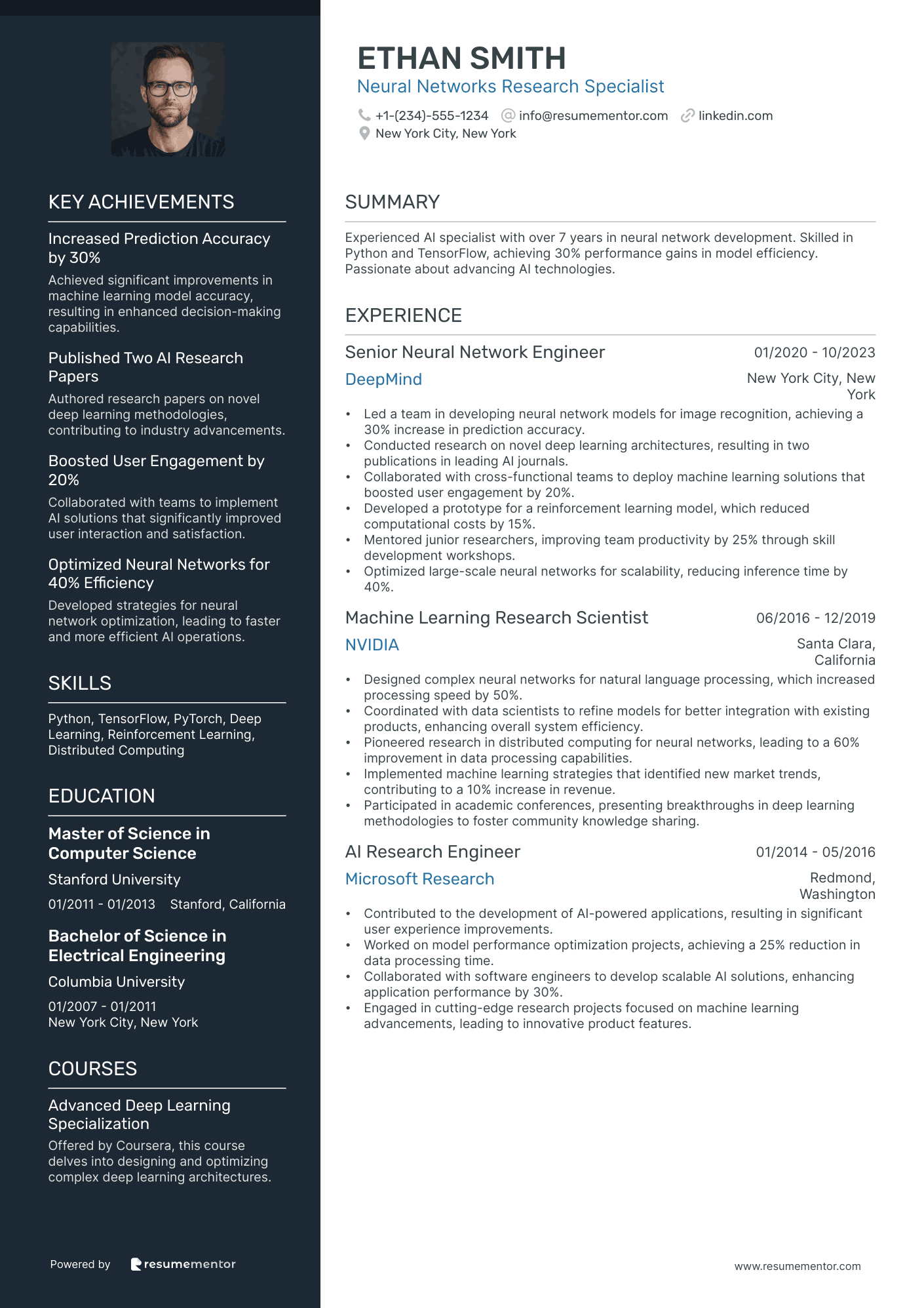
Neural Networks Research Specialist
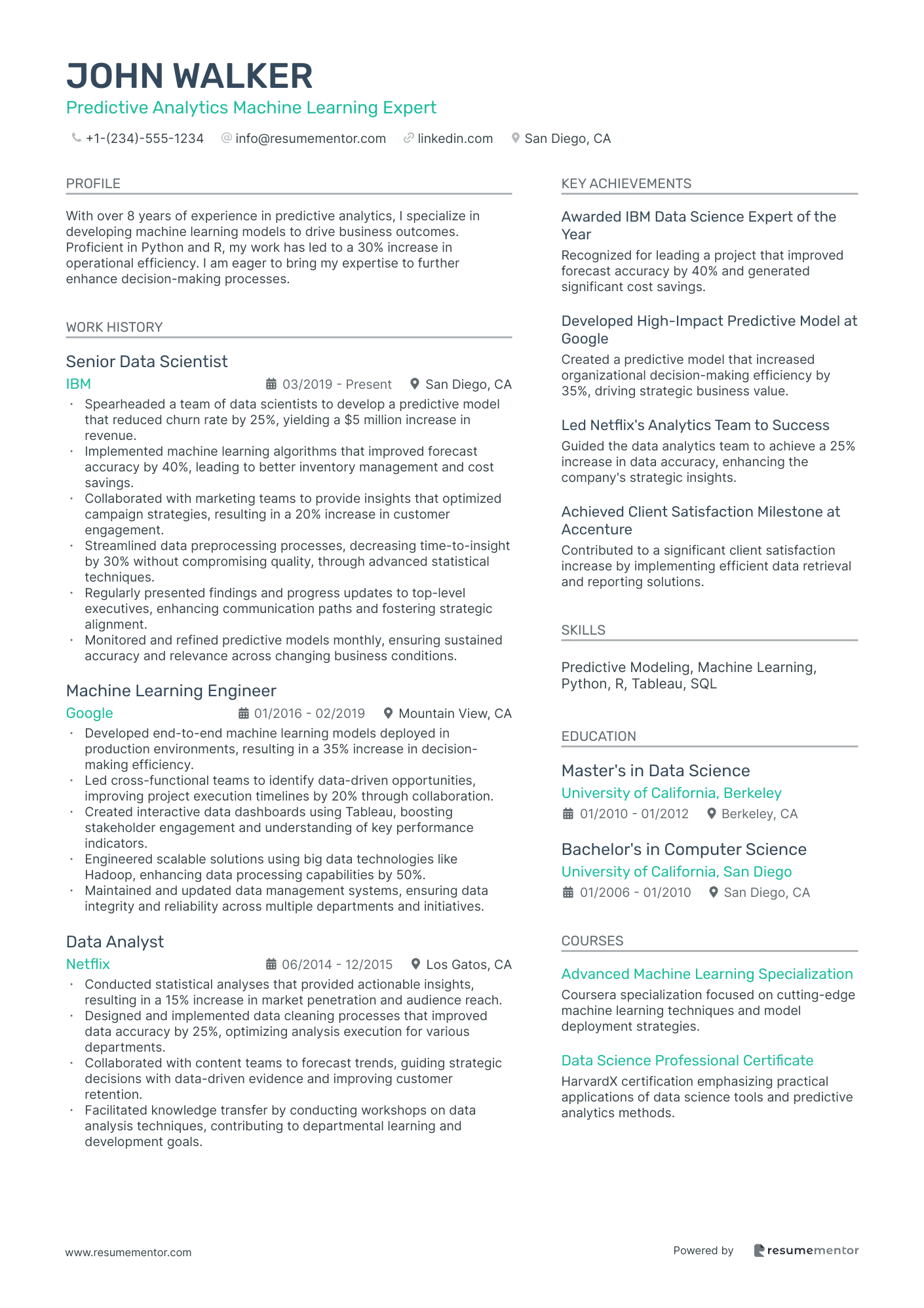
Predictive Analytics Machine Learning Expert
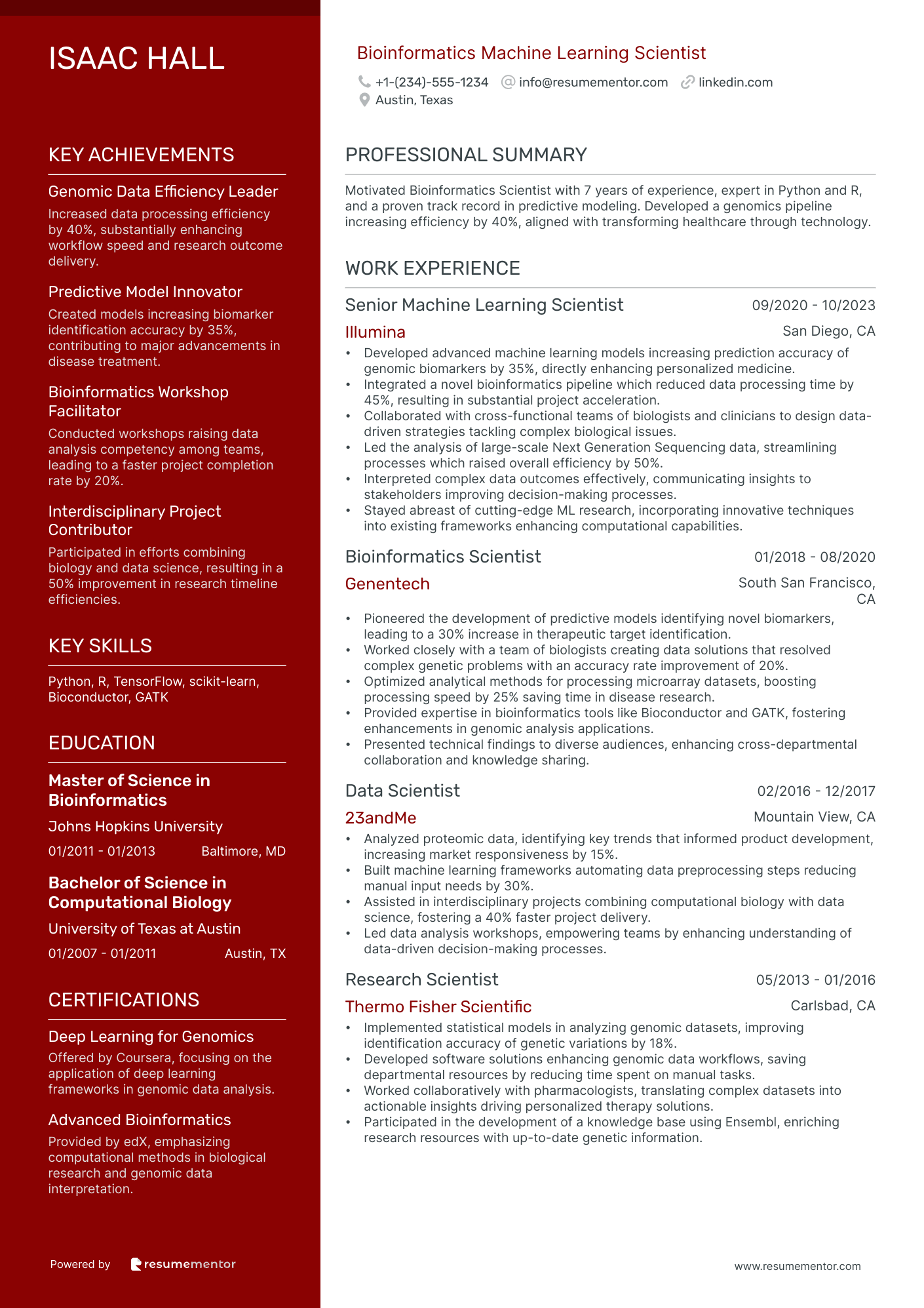
Bioinformatics Machine Learning Scientist
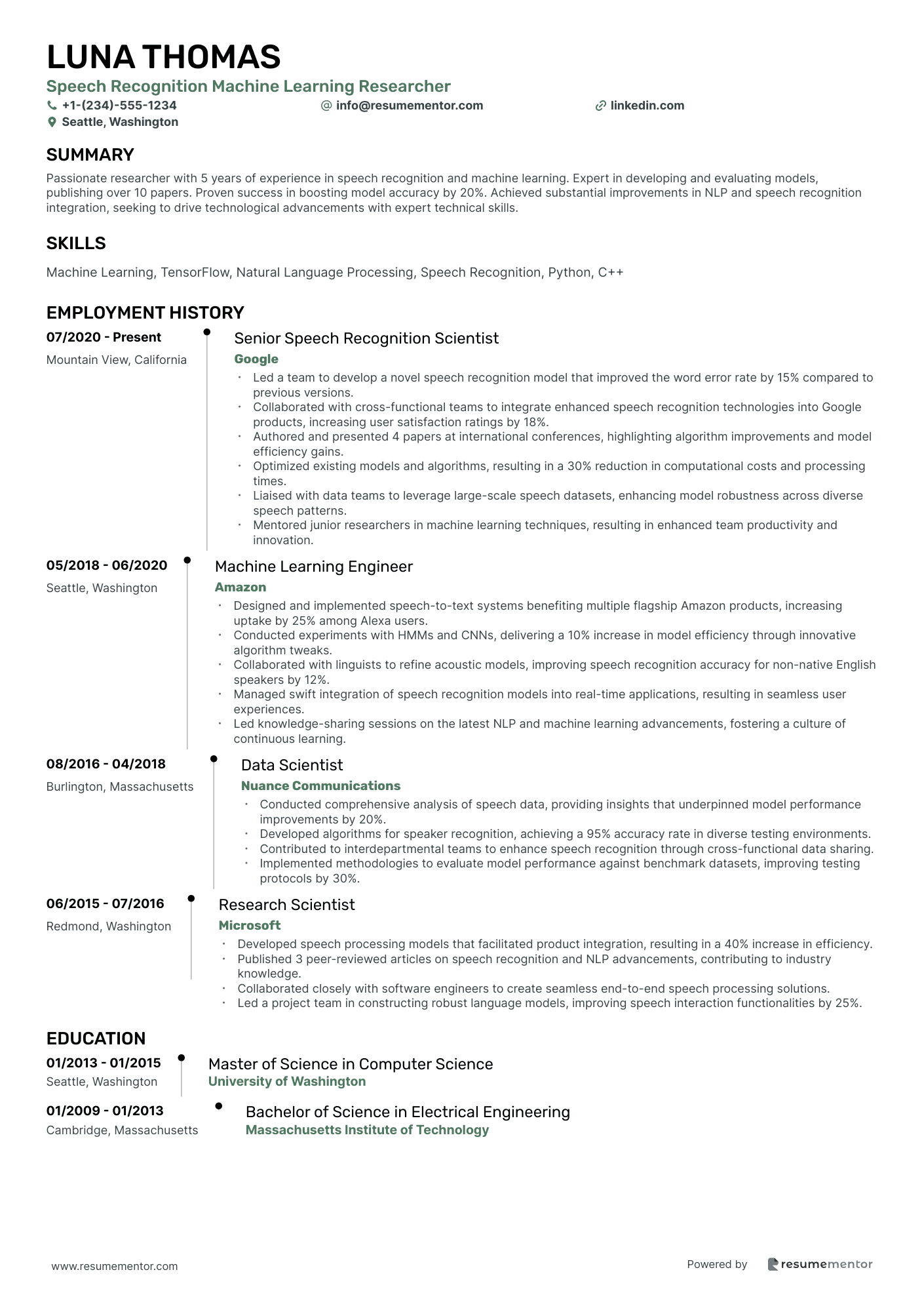
Speech Recognition Machine Learning Researcher

Deep Learning Research Scientist resume sample
- •Developed a machine learning model that increased data processing efficiency by 40%, leading to enhanced system productivity.
- •Led a team of ten in redesigning AI algorithms, improving prediction accuracy by 35%, supporting critical business operations.
- •Authored and presented three papers at top-tier AI conferences, increasing visibility and reputation in the AI research community.
- •Spearheaded collaboration across teams, integrating new deep learning models into three existing products, boosting their performance.
- •Mentored five junior engineers, promoting best practices in deep learning research and development, enhancing team capabilities.
- •Optimized large-scale data analysis to extract actionable insights, advancing business operations and decision-making processes.
- •Designed innovative deep learning solutions, resulting in a 30% reduction in operational costs and resource allocation.
- •Published four research papers in prestigious journals, contributing significantly to the field of deep learning.
- •Implemented cutting-edge algorithms that reduced processing time by 25%, enhancing computational efficiency and effectiveness.
- •Collaborated with cross-functional teams to integrate AI solutions into two key product lines, improving their market competitiveness.
- •Analyzed multi-terabyte datasets to optimize machine learning models, resulting in a 22% performance improvement.
- •Pioneered a new AI architecture, decreasing processing times by 20% and enhancing capability to handle complex computations.
- •Collaborated with clients to understand their AI needs, designing tailored solutions that increased satisfaction by 18%.
- •Improved deep learning model accuracy by 16%, directly impacting product quality and customer experience.
- •Provided training sessions for cross-departmental teams, elevating the organization’s capability to deploy AI efficiently.
- •Designed AI algorithms that enhanced system accuracy by 19%, meeting strategic goals and improving product reliability.
- •Conducted research leading to new insights in AI, publishing findings in two international journals.
- •Worked closely with engineers across disciplines to integrate AI models into existing frameworks, advancing technological capabilities.
- •Executed comprehensive data analyses to identify trends, enhancing machine learning outcomes significantly.
Natural Language Processing Researcher resume sample
- •Led a team of 5 researchers to enhance dialogue systems, boosting response accuracy by 40% through innovative algorithm adjustments.
- •Implemented new NLP models using Hugging Face Transformers, reducing processing time by 25% and improving efficiency.
- •Collaborated with cross-functional teams to integrate state-of-the-art NLP applications into commercial products, resulting in a 50% user satisfaction improvement.
- •Mentored junior researchers, fostering a collaborative culture and improved overall team research outputs by 30%.
- •Published 3 papers in reputed journals, showcasing advancements in natural language generation and model scalability.
- •Enhanced existing NLP frameworks, optimizing performance and scalability, resulting in a 20% increase in model training speed.
- •Conducted research on NLP algorithms optimizing syntax analysis, increasing parsing accuracy by over 20%.
- •Developed NLP solutions for data extraction, which led to a 40% reduction in manual data processing time.
- •Collaborated with 10 data scientists and engineers, integrating advanced NLP models into deployed systems.
- •Presented findings at 2 international conferences, gaining recognition for innovative machine language techniques.
- •Improved existing codebase by implementing new methods, resulting in a 15% performance boost across projects.
- •Explored machine learning solutions for textual analysis, increasing system processing speed by 30%.
- •Developed proprietary NLP tools that scaled across various departments, enhancing project efficiency by 25%.
- •Supported AI integration projects collaborating across teams, driving 15% improvement in system coherence.
- •Customized NLP models for industry-specific applications, resulting in recognized cost-efficiency increases.
- •Conducted linguistic data analysis enhancing models’ language processing capabilities by 18%.
- •Participated in the development of scalable NLP applications, leading to a 22% increase in end-user engagement.
- •Regularly contributed to team discussions aiding in the development of more efficient dialogue systems.
- •Authored multiple technical reports to document project progress and results, increasing internal knowledge sharing by 40%.
Reinforcement Learning Research Scientist resume sample
- •Led a team to optimize reinforcement learning algorithms, resulting in a 25% performance improvement across applications.
- •Developed and deployed a scalable RL model that reduced computational costs by 30%, significantly enhancing efficiency.
- •Published 3 research papers on multi-agent systems in prestigious journals, increasing citation rate by 40%.
- •Collaborated with cross-functional teams to implement AI solutions in real-world scenarios, boosting project success rate by 20%.
- •Mentored 5 junior researchers, leading to an increase in team productivity by 15%.
- •Conducted experiments for hypothesis validation, achieving a high model prediction accuracy increase of 12%.
- •Conducted cutting-edge reinforcement learning research to improve algorithm resilience, with a 10% decrease in error rates.
- •Collaborated with engineers to integrate RL systems into robotics, enhancing robot task efficiency by 15%.
- •Analyzed complex datasets using Python, leading to actionable insights and a decision-making improvement of 20%.
- •Designed innovative experiments that increased model validation accuracy by 8% in real-world applications.
- •Supervised PhD interns, guiding successful project completion and resulting in an overall research output increase.
- •Developed custom deep learning solutions, achieving a 20% boost in processing speeds for AI models.
- •Collaborated with the cloud team to deploy AI models, resulting in a 50% reduction in deployment time.
- •Published 2 papers on reinforcement learning optimization in top conferences, elevating research visibility.
- •Engaged in interdisciplinary projects that led to a 10% increase in project delivery efficiency.
- •Implemented machine learning algorithms to enhance data classification accuracy by 18% across various datasets.
- •Optimized data processing algorithms, contributing to a 25% reduction in data analysis time.
- •Worked with software developers to integrate AI solutions, improving system performance by 12%.
- •Supported the transition to cloud-based architectures, leading to a 30% increase in system scalability.
Quantitative Machine Learning Analyst resume sample
- •Developed and deployed predictive models that increased operational efficiency by 33%, translating to significant cost savings.
- •Collaborated with a team of data scientists and engineers, prioritizing analytics projects that boosted business outcomes by 25%.
- •Conducted detailed quantitative analyses, validating models with an accuracy rate of 95% and ensuring reliable data to inform decisions.
- •Utilized Python and scikit-learn to automate data processing tasks, enhancing team productivity by 40%.
- •Presented complex data findings clearly to executives, leading to data-driven strategic initiatives worth $1.2M annually.
- •Stayed at the forefront of machine learning advancements, integrating 3 new methodologies into existing frameworks.
- •Implemented machine learning models that improved customer retention rates by 20%, increasing revenue by $500K annually.
- •Extracted actionable insights from large datasets, enhancing client deliverables and reducing report generation time by 30%.
- •Led cross-functional teams to develop data-driven solutions, resulting in a successful product launch with 95% KPI achievement.
- •Enhanced predictive model accuracy from 80% to 92% by fine-tuning algorithms, significantly impacting forecast reliability.
- •Communicated data analysis results to non-technical stakeholders, supporting effective decision-making and strategy development.
- •Designed machine learning pipelines that improved data processing speed by 200%, supporting faster decision cycles.
- •Collaborated with software developers to integrate machine learning models into production, ensuring seamless application use.
- •Taught Python coding workshops to a team of 20+ staff, enhancing in-house technical capabilities and project execution.
- •Reduced model training times by 50% through code optimization and resource management strategies.
- •Analyzed sales data trends, uncovering potential market opportunities that led to a 5% increase in regional sales.
- •Designed interactive dashboards using Tableau, enhancing stakeholder understanding of key performance metrics.
- •Developed ad-hoc reports that supported management in strategic planning, resulting in improved business tactics.
- •Automated data entry processes that reduced administrative workloads by 60%, saving approximately 15 hours weekly.
Neural Networks Research Specialist resume sample
- •Led a team in developing neural network models for image recognition, achieving a 30% increase in prediction accuracy.
- •Conducted research on novel deep learning architectures, resulting in two publications in leading AI journals.
- •Collaborated with cross-functional teams to deploy machine learning solutions that boosted user engagement by 20%.
- •Developed a prototype for a reinforcement learning model, which reduced computational costs by 15%.
- •Mentored junior researchers, improving team productivity by 25% through skill development workshops.
- •Optimized large-scale neural networks for scalability, reducing inference time by 40%.
- •Designed complex neural networks for natural language processing, which increased processing speed by 50%.
- •Coordinated with data scientists to refine models for better integration with existing products, enhancing overall system efficiency.
- •Pioneered research in distributed computing for neural networks, leading to a 60% improvement in data processing capabilities.
- •Implemented machine learning strategies that identified new market trends, contributing to a 10% increase in revenue.
- •Participated in academic conferences, presenting breakthroughs in deep learning methodologies to foster community knowledge sharing.
- •Contributed to the development of AI-powered applications, resulting in significant user experience improvements.
- •Worked on model performance optimization projects, achieving a 25% reduction in data processing time.
- •Collaborated with software engineers to develop scalable AI solutions, enhancing application performance by 30%.
- •Engaged in cutting-edge research projects focused on machine learning advancements, leading to innovative product features.
- •Utilized neural network algorithms to improve predictive analytics tools by 35% in accuracy.
- •Developed machine learning pipelines for data analysis, leading to more efficient data processing workflows.
- •Analyzed large datasets to discover insights that influenced strategic business decisions and enhanced product offerings.
- •Designed visualization tools for presenting complex data findings, increasing stakeholder engagement with analytics.
Predictive Analytics Machine Learning Expert resume sample
- •Spearheaded a team of data scientists to develop a predictive model that reduced churn rate by 25%, yielding a $5 million increase in revenue.
- •Implemented machine learning algorithms that improved forecast accuracy by 40%, leading to better inventory management and cost savings.
- •Collaborated with marketing teams to provide insights that optimized campaign strategies, resulting in a 20% increase in customer engagement.
- •Streamlined data preprocessing processes, decreasing time-to-insight by 30% without compromising quality, through advanced statistical techniques.
- •Regularly presented findings and progress updates to top-level executives, enhancing communication paths and fostering strategic alignment.
- •Monitored and refined predictive models monthly, ensuring sustained accuracy and relevance across changing business conditions.
- •Developed end-to-end machine learning models deployed in production environments, resulting in a 35% increase in decision-making efficiency.
- •Led cross-functional teams to identify data-driven opportunities, improving project execution timelines by 20% through collaboration.
- •Created interactive data dashboards using Tableau, boosting stakeholder engagement and understanding of key performance indicators.
- •Engineered scalable solutions using big data technologies like Hadoop, enhancing data processing capabilities by 50%.
- •Maintained and updated data management systems, ensuring data integrity and reliability across multiple departments and initiatives.
- •Conducted statistical analyses that provided actionable insights, resulting in a 15% increase in market penetration and audience reach.
- •Designed and implemented data cleaning processes that improved data accuracy by 25%, optimizing analysis execution for various departments.
- •Collaborated with content teams to forecast trends, guiding strategic decisions with data-driven evidence and improving customer retention.
- •Facilitated knowledge transfer by conducting workshops on data analysis techniques, contributing to departmental learning and development goals.
- •Advised clients on data strategies that enhanced business operations efficiency by 18%, aligning technological capabilities with strategic goals.
- •Devised reporting tools that automated data visualization, reducing manual report generation times by 40% while increasing accuracy.
- •Conducted gap analyses to identify areas for improvement, leading to process optimizations that improved overall client satisfaction scores.
- •Customized database solutions that streamlined data retrieval and analysis processes, allowing for quicker and more accurate reporting.
Bioinformatics Machine Learning Scientist resume sample
- •Developed advanced machine learning models increasing prediction accuracy of genomic biomarkers by 35%, directly enhancing personalized medicine.
- •Integrated a novel bioinformatics pipeline which reduced data processing time by 45%, resulting in substantial project acceleration.
- •Collaborated with cross-functional teams of biologists and clinicians to design data-driven strategies tackling complex biological issues.
- •Led the analysis of large-scale Next Generation Sequencing data, streamlining processes which raised overall efficiency by 50%.
- •Interpreted complex data outcomes effectively, communicating insights to stakeholders improving decision-making processes.
- •Stayed abreast of cutting-edge ML research, incorporating innovative techniques into existing frameworks enhancing computational capabilities.
- •Pioneered the development of predictive models identifying novel biomarkers, leading to a 30% increase in therapeutic target identification.
- •Worked closely with a team of biologists creating data solutions that resolved complex genetic problems with an accuracy rate improvement of 20%.
- •Optimized analytical methods for processing microarray datasets, boosting processing speed by 25% saving time in disease research.
- •Provided expertise in bioinformatics tools like Bioconductor and GATK, fostering enhancements in genomic analysis applications.
- •Presented technical findings to diverse audiences, enhancing cross-departmental collaboration and knowledge sharing.
- •Analyzed proteomic data, identifying key trends that informed product development, increasing market responsiveness by 15%.
- •Built machine learning frameworks automating data preprocessing steps reducing manual input needs by 30%.
- •Assisted in interdisciplinary projects combining computational biology with data science, fostering a 40% faster project delivery.
- •Led data analysis workshops, empowering teams by enhancing understanding of data-driven decision-making processes.
- •Implemented statistical models in analyzing genomic datasets, improving identification accuracy of genetic variations by 18%.
- •Developed software solutions enhancing genomic data workflows, saving departmental resources by reducing time spent on manual tasks.
- •Worked collaboratively with pharmacologists, translating complex datasets into actionable insights driving personalized therapy solutions.
- •Participated in the development of a knowledge base using Ensembl, enriching research resources with up-to-date genetic information.
Speech Recognition Machine Learning Researcher resume sample
- •Led a team to develop a novel speech recognition model that improved the word error rate by 15% compared to previous versions.
- •Collaborated with cross-functional teams to integrate enhanced speech recognition technologies into Google products, increasing user satisfaction ratings by 18%.
- •Authored and presented 4 papers at international conferences, highlighting algorithm improvements and model efficiency gains.
- •Optimized existing models and algorithms, resulting in a 30% reduction in computational costs and processing times.
- •Liaised with data teams to leverage large-scale speech datasets, enhancing model robustness across diverse speech patterns.
- •Mentored junior researchers in machine learning techniques, resulting in enhanced team productivity and innovation.
- •Designed and implemented speech-to-text systems benefiting multiple flagship Amazon products, increasing uptake by 25% among Alexa users.
- •Conducted experiments with HMMs and CNNs, delivering a 10% increase in model efficiency through innovative algorithm tweaks.
- •Collaborated with linguists to refine acoustic models, improving speech recognition accuracy for non-native English speakers by 12%.
- •Managed swift integration of speech recognition models into real-time applications, resulting in seamless user experiences.
- •Led knowledge-sharing sessions on the latest NLP and machine learning advancements, fostering a culture of continuous learning.
- •Conducted comprehensive analysis of speech data, providing insights that underpinned model performance improvements by 20%.
- •Developed algorithms for speaker recognition, achieving a 95% accuracy rate in diverse testing environments.
- •Contributed to interdepartmental teams to enhance speech recognition through cross-functional data sharing.
- •Implemented methodologies to evaluate model performance against benchmark datasets, improving testing protocols by 30%.
- •Developed speech processing models that facilitated product integration, resulting in a 40% increase in efficiency.
- •Published 3 peer-reviewed articles on speech recognition and NLP advancements, contributing to industry knowledge.
- •Collaborated closely with software engineers to create seamless end-to-end speech processing solutions.
- •Led a project team in constructing robust language models, improving speech interaction functionalities by 25%.
Navigating the job market as a machine learning researcher can feel like solving a complex algorithm; you need a thoughtful approach to get it right. One of the most crucial steps is crafting a resume that translates your technical expertise into a compelling narrative. This task can be daunting, but it’s essential for standing out in a competitive field.
A well-structured resume template can make this process easier by providing a reliable framework to present your achievements and skills. By choosing the right resume template, you can ensure your document is both clear and professional, making an excellent first impression.
To capture the essence of your work, you must convey your contributions in a way that's easy to grasp. Organizing your resume with clearly defined sections allows you to showcase your research impact, skills, and publications, ensuring your unique qualities shine.
Your resume should be more than just a job history; it’s a reflection of your career journey. By effectively sharing your story—from groundbreaking projects to collaborative efforts—you set the stage for impactful interviews. With the right guidance and tools, you can transform this essential document into a powerful testament to your machine learning prowess.
Key Takeaways
- Crafting a resume that effectively communicates expertise is essential for standing out in the competitive field of machine learning research.
- A well-structured resume should include clearly defined sections to showcase technical skills, research contributions, and career journey.
- Choosing the right resume format, such as reverse-chronological, ensures that your accomplishments are highlighted clearly and concisely.
- Education and certifications should be relevant to the field, demonstrating your dedication to ongoing learning and expertise.
- Including extra sections like languages, hobbies, volunteer work, and influential books can showcase a well-rounded and versatile profile.
What to focus on when writing your machine learning researcher resume
A machine learning researcher resume should effectively convey your in-depth expertise, your valuable contributions, and your strong analytical skills in the ever-evolving field of machine learning. Recruiters need a swift understanding of your qualifications and relevant project experience to determine your fit for their needs.
How to structure your machine learning researcher resume
- Contact Information: Start with your full name, phone number, professional email, and an updated LinkedIn profile—these elements ensure recruiters can easily reach out to you for the next steps in the hiring process.
- Professional Summary: Present a compelling overview of your machine learning expertise, drawing attention to your specific area of specialization and notable achievements—this sets the stage for what you bring to the table and piques the recruiter's interest right from the start.
- Technical Skills: Provide a detailed list of programming languages, frameworks, and tools where you excel, such as Python, TensorFlow, and PyTorch—highlighting these skills not only shows your technical prowess but also aligns you with the technical requirements of machine learning roles.
- Work Experience: Elaborate on your previous roles by describing specific projects where you were instrumental in developing algorithms or data analysis—this connection to your skills demonstrates how you apply your knowledge in practical settings, which is crucial for a machine learning researcher role.
- Education: Share comprehensive information about your academic background, including degrees in relevant fields—emphasize courses in machine learning or data science as a testament to your theoretical knowledge and preparedness for advanced challenges.
- Publications and Research: Highlight any significant papers, articles, or conference presentations you authored—these showcase your contributions to the field and underline your commitment to advancing machine learning.
Consider additional sections such as Certifications, Awards, Projects, or Languages to further bolster your resume. These elements offer a comprehensive view of your qualifications and achievements. Next, we'll explore how to format your resume effectively and delve deeper into each critical section.
Which resume format to choose
Choosing the right resume format is crucial for writing a machine learning researcher resume because it shapes how your experience is viewed. The reverse-chronological format is especially effective in this field, as it not only showcases your most recent achievements but also highlights technical skills and projects in a straightforward manner.
For fonts, it's important to convey professionalism and clarity. Modern fonts like Montserrat, Lato, and Chivo do just that by providing a clean aesthetic that supports your content without distracting from it. They help ensure that technical details are easy to read, which is critical when you're dealing with complex information.
When it comes to saving your work, using a PDF format is non-negotiable. This file type locks in your formatting, ensuring that your resume looks polished regardless of the device or platform a hiring manager is using. Consistency is key, and PDFs deliver that seamlessly.
Finally, consider the layout of your resume with one-inch margins on all sides. This not only keeps the document looking neat and professional but also provides ample space for technical diagrams or notes. A well-organized layout aids in making a dense resume easy to navigate, ensuring that key details, like research projects and publications, are never missed. This comprehensive approach ensures that your resume effectively communicates your qualifications in the competitive space of machine learning.
How to write a quantifiable resume experience section
The experience section of your machine learning researcher resume is essential because it highlights your achievements and abilities in a cohesive manner. By focusing on results-driven and quantifiable accomplishments, you can clearly demonstrate your impact in previous roles. Begin with your most recent experience and work backward, typically covering the last 10-15 years unless earlier positions are highly relevant. This ensures that your career timeline is logical and easy to follow. Tailor your resume to the job you want by integrating keywords from the job description, helping potential employers see the connection between your skills and their needs. Use titles that align with the position you're applying for to make your experience immediately recognizable. Action words like "developed," "implemented," "analyzed," and "led" effectively convey ownership and impact, painting a vivid picture of your contributions.
- •Developed a new algorithm that increased prediction accuracy by 25%, reducing operational costs by $500,000 annually.
- •Implemented a deep learning model that improved data processing speed by 40%, enabling faster decision-making.
- •Led a team of 5 researchers in a project that resulted in 3 published papers in top-tier AI journals.
- •Analyzed customer behavior data, enhancing product recommendation systems and boosting sales by 15%.
This experience section is compelling because it interweaves your direct impact with concrete achievements and measurable outcomes, creating a comprehensive narrative. The bullet points flow logically, each building on the previous one, to illustrate the breadth of your contributions in a cohesive and engaging way. With a structured approach, from the ordering of roles to the strategic use of active language, it effectively communicates your expertise and aligns with industry standards. This tailored presentation ensures potential employers can easily envision your role in their organization, ultimately enhancing your candidacy.
Industry-Specific Focus resume experience section
A machine learning-focused researcher's resume experience section should clearly highlight achievements, technical skills, and industry expertise. Start by pinpointing projects or roles that align closely with the job you're targeting, and make sure to articulate your position and its impact within your team or organization. Enhancing credibility with measurable outcomes can provide concrete evidence of your capabilities, and it's crucial to tailor each entry to showcase skills and results that are most pertinent to the position.
Each bullet point should illuminate a distinct aspect of your experience, starting with strong action verbs while steering clear of jargon that's not easily understood. Use simple, concise language to convey your contributions and achievements. Present your information in a compelling, easy-to-read way, creating a seamless narrative of your career progression and the unique value you've added in each role.
Machine Learning Researcher
Innovative AI Solutions Inc.
June 2020 - Present
- Designed and implemented machine learning models to predict customer trends, increasing accuracy by 20%.
- Collaborated with cross-functional teams to integrate AI solutions, resulting in a 15% reduction in operational costs.
- Developed an automated data pipeline to manage and pre-process vast datasets, boosting efficiency by 30%.
- Published two research papers in leading AI journals, enhancing the team's visibility in the industry.
Innovation-Focused resume experience section
A machine learning researcher-focused resume experience section should effectively spotlight how your problem-solving skills, creativity, and impactful research have driven innovation. Begin by describing projects where you have pushed boundaries or applied machine learning in unique ways. Use success metrics and tangible outcomes to underscore the importance of your contributions and mention key tools and technologies you've employed.
Each bullet point should represent an achievement rather than merely listing tasks, weaving a cohesive narrative. Start with strong action verbs to portray your role and impact clearly, and weave in details about collaborations, recognitions, or publications linked to your work. Illustrate how your innovative efforts have contributed to project or organizational success, tailoring the details to align with the job you are applying for.
Senior Machine Learning Researcher
AI Innovations Lab
Jan 2021 - Present
- Developed a novel algorithm that boosted image recognition accuracy by 15%, enhancing diagnostic capabilities.
- Led a team of four researchers to merge AI with IoT devices, paving the way for new remote monitoring systems.
- Published two papers in top-tier journals, showcasing advancements in natural language processing techniques.
- Worked with cross-functional teams to apply machine learning models in real-world settings, improving user experience by 20%.
Growth-Focused resume experience section
A growth-focused machine learning researcher resume experience section should clearly illustrate your achievements and the impact of your work. Start by highlighting the specific skills you employed and how they contributed to important projects or research endeavors. This approach not only shows your ability to tackle complex problems but also underscores your potential to drive future success within an organization. Each bullet point should highlight a distinct skill or accomplishment, using action verbs to make your contributions engaging to potential employers.
To create a seamless flow, begin each bullet with a compelling action word that emphasizes your role in various projects. Clearly explain how your efforts benefited the team, project, or company. For example, if you developed an algorithm that increased processing speed, describe its impact on the company’s efficiency. Whether you collaborated with colleagues or led a project, be sure to emphasize your leadership and teamwork skills. By thoughtfully connecting these aspects of your experience, you'll help employers envision how you can contribute to their organization’s growth.
Machine Learning Researcher
Tech Innovations Inc.
2020 - 2023
- Implemented a novel algorithm, increasing data processing speed by 30% and significantly enhancing project efficiency.
- Led a team of 5 researchers to develop a machine learning model, resulting in a 20% increase in predictive accuracy.
- Collaborated with cross-functional teams to integrate machine learning solutions, boosting overall operational productivity by 15%.
- Authored 3 research papers published in peer-reviewed journals, advancing the understanding of neural network applications.
Problem-Solving Focused resume experience section
A problem-solving-focused machine learning researcher resume experience section should highlight how you address and resolve complex challenges while making a significant impact. Begin by stating the timeframe and a descriptive title that encapsulates your contribution. Follow with bullet points that weave together the issues you've tackled, the actions you took, and the successful outcomes. Use metrics and specific achievements to underscore your skills, such as improving model accuracy or reducing processing time, emphasizing the link between your efforts and the results.
If you include a brief description about the workplace, keep it relevant and succinct, providing context that ties back to your achievements. Throughout this section, aim to seamlessly connect your experiences, showing potential employers how your problem-solving abilities consistently lead to tangible benefits. Being clear and concise, while also tailoring your content to the job at hand, ensures you illustrate the direct value you can bring to their team.
Machine Learning Researcher
Tech Innovations Inc.
June 2020 - Present
- Reduced model training time by 30% with a new algorithm strategy.
- Developed a real-time recommendation system that boosted user engagement by 25%.
- Designed a predictive maintenance model that cut equipment downtime by 15%.
- Collaborated with teams to integrate machine learning solutions, lifting overall project accuracy by 10%.
Write your machine learning researcher resume summary section
A well-crafted machine learning researcher resume should start with a summary that highlights your strengths and career trajectory. This section tells your professional story through your skills, achievements, and goals, helping you stand out to potential employers. You need to balance being informative and concise while reflecting your work journey. Take this example for an experienced machine learning researcher:
This example effectively combines experience, proficiency, and contributions, demonstrating your dedication and expertise. If you're in the early stages of your career, an objective statement might suit you better by focusing on your aspirations and skill set. Consider this for an entry-level researcher:
[here was the JSON object 2]
Both examples clearly connect your goals with your skills, making it easier for employers to see your potential fit within their teams. Understanding the difference between a summary and an objective is key; a summary focuses on experience, while an objective highlights your career direction and eagerness to develop skills. The resume profile merges both aspects with an emphasis on specific traits, whereas a summary of qualifications offers a bullet-point view of your skills and achievements. Choosing the right type depends on your career stage and how you wish to present yourself to recruiters.
Listing your machine learning researcher skills on your resume
A skills-focused machine learning researcher resume should present your skills strategically, either in a standalone section or integrated seamlessly with your experience and summary. By highlighting both your strengths and soft skills, like teamwork and problem-solving, you set yourself apart from other candidates. Hard skills, such as programming languages and data analysis, are crucial for handling specific tasks in machine learning research and should not be overlooked.
Consider your skills and strengths as key resume keywords. These keywords are vital not only for capturing the attention of hiring managers but also for ensuring that automated systems flag your resume as a perfect match for the job. Customizing these keywords to align with the job description helps accentuate your qualifications.
Here's an example of a standalone skills section that effectively achieves these goals:
This skills section is effective because it enumerates key competencies for a machine learning researcher. Terms like Python and TensorFlow are industry benchmarks, demonstrating your technical capabilities and improving your resume's searchability.
Best hard skills to feature on your machine learning researcher resume
These hard skills are the foundation of a machine learning researcher's toolkit. They demonstrate your technical proficiency and readiness to tackle industry-specific challenges, contributing immediate value to any team.
Hard Skills
- Python Programming
- TensorFlow
- PyTorch
- Data Analysis
- Statistical Modeling
- Machine Learning Algorithms
- R Programming
- Deep Learning
- Natural Language Processing (NLP)
- Big Data Technologies
- Cloud Computing
- SQL
- Bayesian Networks
- Computer Vision
- Reinforcement Learning
Best soft skills to feature on your machine learning researcher resume
Soft skills are equally important and show your ability to thrive in a collaborative research environment. They highlight your adaptability, creativity, and problem-solving skills, all of which are essential for successful teamwork and project delivery.
Soft Skills
- Problem-Solving
- Communication
- Teamwork
- Creativity
- Time Management
- Adaptability
- Critical Thinking
- Initiative
- Collaboration
- Leadership
- Attention to Detail
- Emotional Intelligence
- Conflict Resolution
- Decision Making
- Stress Management
How to include your education on your resume
The education section of a resume is vital because it provides the foundation of your expertise. As a machine learning researcher, ensuring the education section is tailored to the job in question is crucial. Exclude education that doesn't directly relate to the field or enhance your qualifications for the role you are seeking. When mentioning your GPA, include it if it strengthens your application, placing it beside your degree in parentheses. For honors like cum laude, list them immediately after your degree title to highlight your achievements. Include your degree in a clear format, starting with the degree type, major, and any relevant honors.
The wrong example of an education section could confuse potential employers or suggest a lack of focus. An effective example presents qualifications that align with potential job responsibilities, providing clarity and impact.
Here is a wrong example:
- •Focused on literary analysis and creative writing
Now, here's a right example:
The latter example is strong because it highlights a degree in Computer Science, which is relevant to machine learning. It includes notable achievements, such as graduating cum laude, and features a strong GPA of 3.8. This clarity ensures that hiring managers immediately recognize your qualifications and focus, making your resume more impactful.
How to include machine learning researcher certificates on your resume
Including a certificates section in your resume is essential for a machine learning researcher, as it showcases your dedication to ongoing learning and your expertise in the field. You can also integrate certificates into the header for a cleaner look.
List the name of each certificate. Include the date you received it. Add the issuing organization to give it credibility.
These certificates are great examples for a machine learning researcher. They are specific to the skills needed, such as machine learning and deep learning from credible sources like Coursera and IBM. This ensures that potential employers recognize and value your certifications.
Extra sections to include in your machine learning researcher resume
In an ever-evolving field like machine learning, having a well-rounded resume can set you apart from other candidates. Showcasing your expertise and diverse experiences will help demonstrate your full potential.
- Language section—highlight being multilingual to show strong communication skills and the ability to work in diverse environments.
- Hobbies and interests section—mention hobbies that can indirectly benefit your work, such as playing chess for strategic thinking or coding competitions for problem-solving skills.
- Volunteer work section—include volunteer experience to demonstrate your commitment to the community and your teamwork skills, which are crucial for collaborative projects.
- Books section—list influential books to reflect your dedication to continuous learning and staying updated with industry trends and theories.
Your well-rounded background will make you stand out as a versatile and dedicated candidate. Embrace these sections to show both your professional and personal strengths. Each point will speak volumes about your character and capabilities.
In Conclusion
In conclusion, navigating the job market as a machine learning researcher requires a carefully crafted strategy. Your resume is more than just a document; it is your personal narrative that showcases your journey, skills, and achievements. By using a structured template, you can present your technical expertise effectively, ensuring clarity and professionalism. Highlighting key sections, such as your contact information, professional summary, technical skills, work experience, and education, forms the backbone of a strong resume. Including quantifiable accomplishments paints a vivid picture of your impact and sets you apart in a competitive field. Furthermore, adding sections that showcase your certifications, languages, and other relevant experiences will demonstrate your commitment to continuous learning and growth.
Your resume should reflect not only your technical skills but also your soft skills that foster teamwork and creativity. These skills complement your hard skills, making you a well-rounded candidate. Choose the right resume format, ensuring it remains clean and easy to read by using professional fonts and saving your document as a PDF. This approach will guarantee that your resume makes a lasting impression and communicates your qualifications effectively.
Remember, potential employers are looking for more than just experience; they seek candidates ready to contribute and grow within their teams. By focusing on your unique strengths and presenting them in a polished manner, your resume becomes a powerful tool in your job search, opening doors to exciting opportunities in the world of machine learning.
Related Articles

Continue Reading
Check more recommended readings to get the job of your dreams.
Resume
Resources
Tools
© 2025. All rights reserved.
Made with love by people who care.

